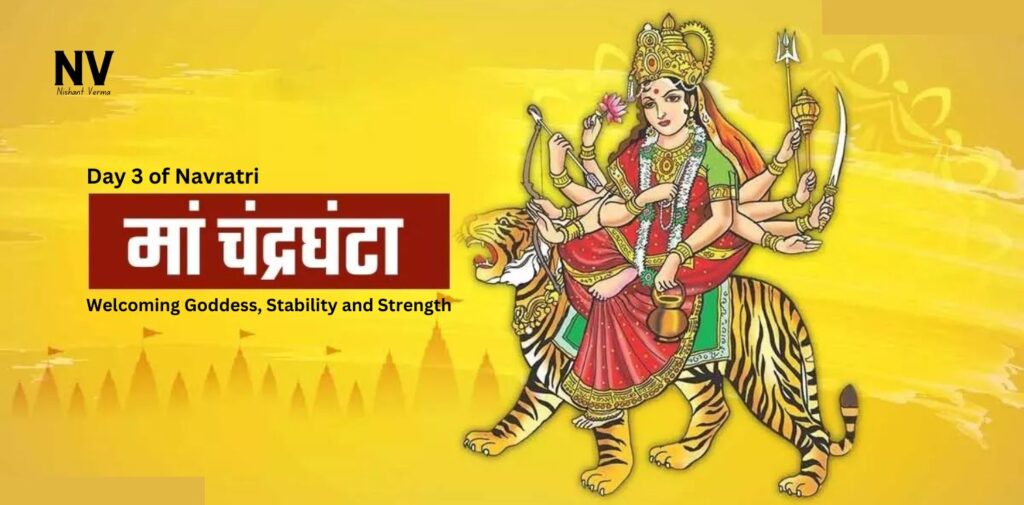Navratri, one of the most celebrated and auspicious Hindu festivals, is marked by devotion, spirituality, and reverence towards the nine divine forms of Goddess Durga. Each day of Navratri is dedicated to a different form of the goddess, and on the third day, we worship Goddess Chandraghanta. With her radiant appearance and calming aura, she symbolizes peace, courage, and balance.
In this article, we delve in-depth into the significance of Goddess Chandraghanta, her unique attributes, and the lessons we can draw from her on the third day of Navratri.
Who is Goddess Chandraghanta?
Goddess Chandraghanta, the third manifestation of Goddess Durga, is revered for her fierce yet composed nature. The name “Chandraghanta” is derived from two words: “Chandra,” meaning moon, and “Ghanta,” meaning bell. Her name signifies a crescent moon-shaped bell on her forehead, which embodies serenity and courage.
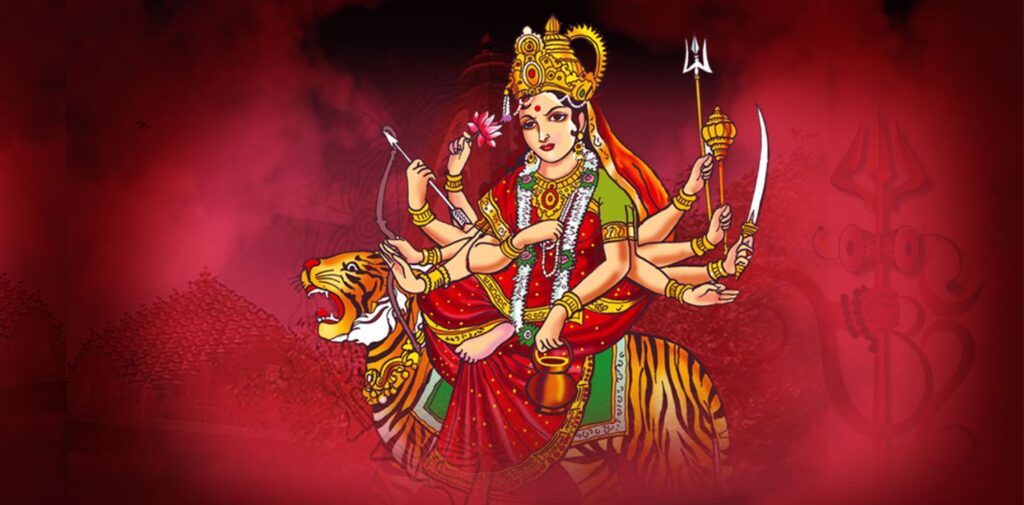
She is portrayed riding a lion, symbolizing bravery, with ten hands holding various weapons like a sword, trident, and mace, among others. These weapons signify her readiness to fight against evil forces and protect her devotees. Yet, her peaceful face and the bell on her forehead reflect tranquility and divine grace.
Symbolism of Goddess Chandraghanta
Strength and Valor: The ferocious weapons in her hands denote the immense strength and valor she possesses to overcome all difficulties in life. She is the epitome of courage and willpower, encouraging us to confront challenges head-on.
Peace and Harmony: The crescent moon on her forehead and her calm expression signify peace and harmony. Despite being armed, she maintains a tranquil demeanor, teaching us that true strength lies in remaining calm amidst chaos.
Victory over Evil: Riding a lion, she represents fearlessness. Goddess Chandraghanta’s image reminds us to stand firm in the face of adversity and combat negativity with positivity and wisdom.
Spiritual Enlightenment: The sound of the bell (ghanta) on her forehead wards off evil spirits and negative energies. It symbolizes spiritual awakening, dispelling ignorance and darkness from our minds and surroundings.
The Story Behind Goddess Chandraghanta
The legend of Goddess Chandraghanta is tied to the marriage of Lord Shiva and Goddess Parvati. After convincing Lord Shiva to marry her, Goddess Parvati adorned herself as Goddess to show her readiness and devotion. When Lord Shiva arrived at King Himavan’s palace in a fierce form with a procession of ghosts and goblins, Goddess Parvati transformed into Chandraghanta to restore peace and balance, making Shiva’s form more acceptable and serene. This act of bringing stability and harmony is celebrated on the third day of Navratri.
Rituals and Customs on the Third Day of Navratri
The third day of Navratri is marked by special prayers and offerings to Goddess Chandraghanta. Devotees perform rituals with great devotion and seek her blessings for courage, stability, and inner peace.
Morning Prayer and Ritual Bath: Devotees begin the day with an early morning bath and wear clean, preferably yellow or golden-colored attire, symbolizing purity and light. The home and altar are cleaned and decorated with flowers, especially yellow and red marigolds, which are considered auspicious.
Altar Decoration and Offerings: The altar is decorated with an idol or image of Goddess. Offerings like milk, sweets made of milk, fruits, and red flowers are placed before her. The offering of milk signifies purity and is believed to purify the mind and soul.
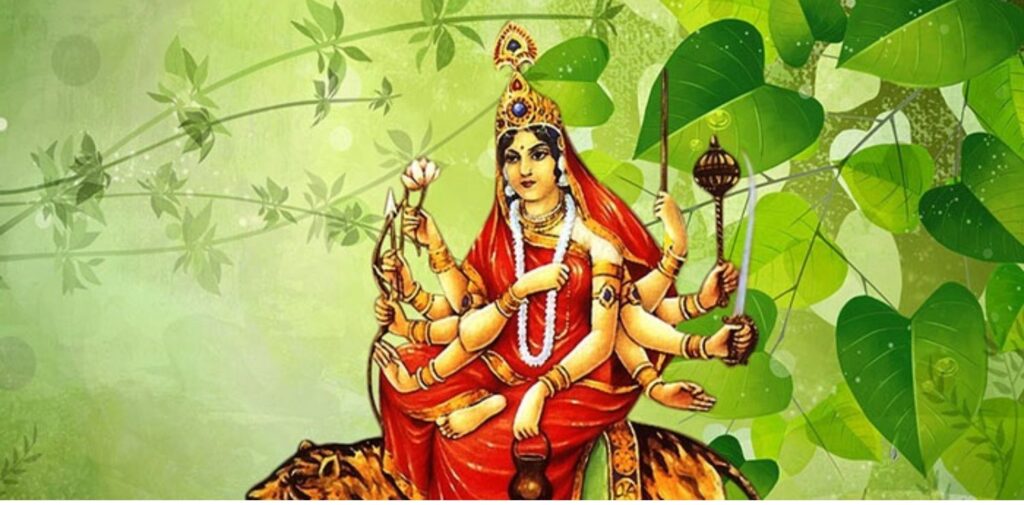
Chanting Mantras: Devotees chant mantras like “Om Devi Chandraghantayai Namah” to invoke her blessings. The sound of bells is considered auspicious, and ringing bells while chanting is believed to ward off negative energies.
Meditation and Reflection: Devotees are encouraged to meditate and reflect on their inner strength and stability. The blessings are sought to gain the courage to face personal struggles and maintain peace.
The Importance of Stability and Strength in Our Lives
The qualities of stability and strength are vital in leading a balanced and successful life. In today’s fast-paced world, where stress and anxiety have become common, Goddess Chandraghanta’s attributes are more relevant than ever.
Emotional Stability: Just as Goddess Chandraghanta remains calm and composed, even while holding powerful weapons, we too should strive to maintain emotional stability amidst life’s challenges. Emotional stability helps in making rational decisions and keeps us grounded.
Mental Strength: In times of adversity, it is our mental strength that keeps us going. This teaches us to harness our inner strength and use it positively. This strength does not mean suppressing emotions but managing them wisely.
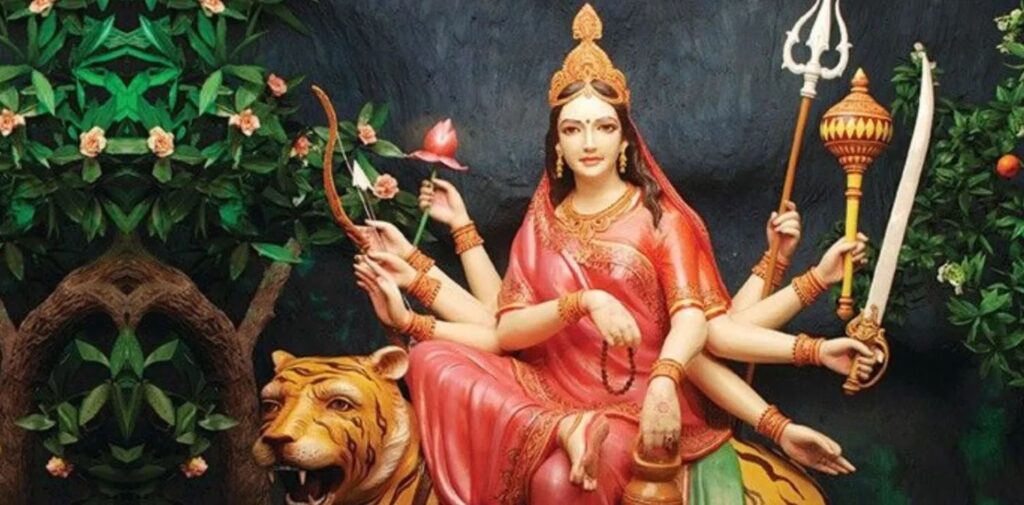
Balancing Responsibilities: The goddess, with her many hands, signifies the ability to handle multiple responsibilities without losing focus. Similarly, we need to balance our personal, professional, and social responsibilities with grace.
Inner Peace: The calm expression reflects that real strength is found in maintaining inner peace. Being at peace with oneself reduces stress and increases overall well-being.
Lessons from Goddess Chandraghanta’s Teachings
Face Challenges Fearlessly: Life is full of challenges, and each challenge tests our resilience. Goddess Chandraghanta inspires us to confront these challenges head-on without fear or hesitation.
Maintain Balance: Just as Goddess Chandraghanta balances her ferocity with a calm demeanor, we too should balance our emotions, work, and relationships. Balance is key to a harmonious and fulfilled life.
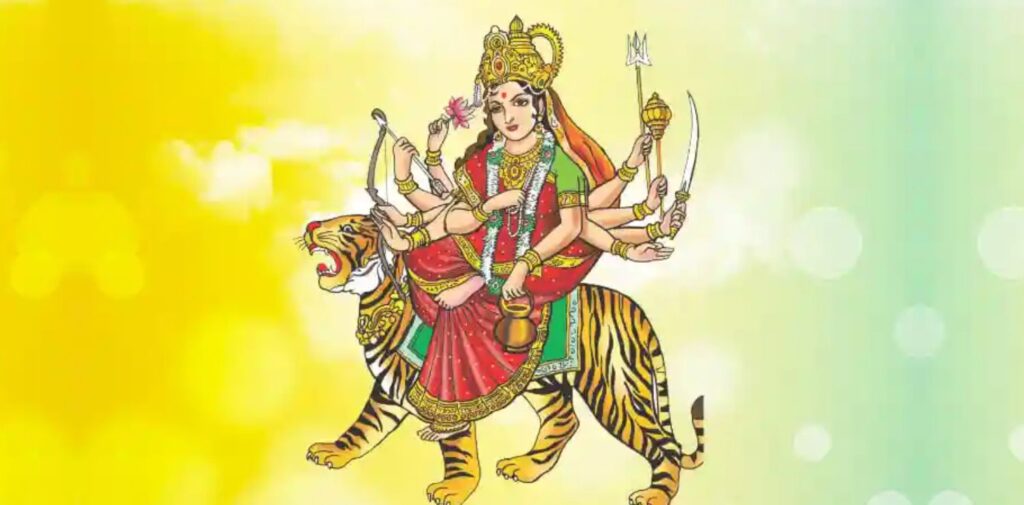
Embrace Spiritual Growth: The third day of Navratri is a reminder to focus on spiritual growth. Engaging in meditation and self-reflection helps clear negative thoughts and leads to enlightenment.
Be Compassionate and Kind: Though armed, Goddess Chandraghanta’s expression is filled with kindness and compassion. We should also strive to be kind and compassionate in our interactions, irrespective of our external circumstances.
Conclusion: The Relevance of Goddess Chandraghanta’s Teachings Today
As we worship Goddess on the third day of Navratri, it’s essential to internalize her qualities of stability, strength, and peace. In a world that often values aggression and assertiveness, the message of calmness and inner strength is a beacon of hope and positivity. By seeking her blessings, we can find the courage to overcome obstacles, the stability to stay grounded, and the wisdom to lead a peaceful life.
May Goddess Chandraghanta’s grace and strength guide us all towards a path of righteousness, courage, and inner peace.

